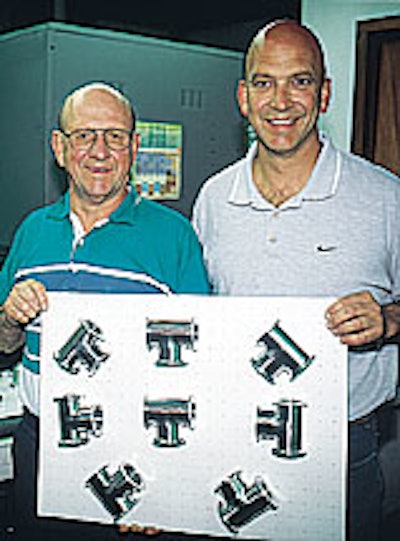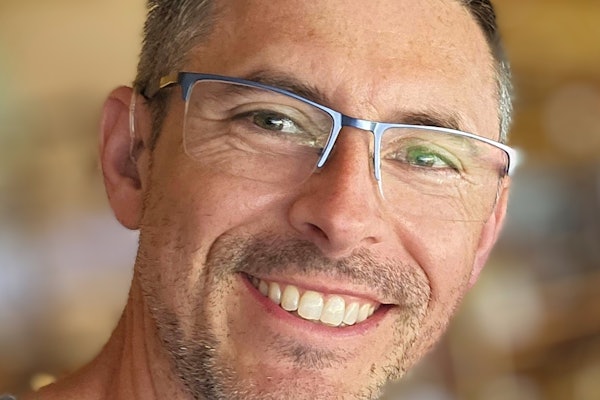Until early this year, Process Pipe & Valve (PPV) manually packed stainless-steel components in newspapers and premade 5-mil polyethylene bags. It then placed the wrapped components into corrugated cases, using cut pieces of corrugated both as dividers between components in the case and along case sidewalls for added protection during shipping. But that process was labor intensive for the Kenosha, WI-based company.
In March, PPV installed a Model 405 T semi-automatic skin packaging machine from Hannan Products (Corona, CA). The machine is currently used 10 to 12 hours per week in a low-volume operation. “We’re a ‘job shop’ that fabricates, welds, and polishes custom stainless-steel components,” explains Don LaJeunesse, who co-owns PPV along with his father, Donald “Dutch” LaJeunesse. PPV functions like a subcontractor, finishing components that it ships back to the component supplier. The finished components are eventually used by machine manufacturers that build processing equipment used in pharmaceutical, food, dairy, and beverage applications.
“We were struggling to get parts out the door during some of our busier periods,” says Don LaJeunesse. “Last summer, we added a full-time person to do all our packaging, and other tasks. But he had a tough time keeping up because we often had to cut dividers out of cases my dad would procure from local stores.”
Distributor plays role
PPV looked to upgrade its packaging process, but without overspending. Initially, the company sought used equipment through a vendor it learned of through last fall’s Pack Expo show. While researching machine options, LaJeunesse also investigated materials. His search led him to the New Berlin, WI, location of distributor Unisource (Norcross, GA).
Not only did Unisource find appropriate materials, it also steered PPV to “a brand-new skin packaging machine, complete with a warranty, for $5ꯠ, about the same price we almost paid for a used machine,” he says with satisfaction. Unisource represents Hannan equipment.
Unisource and Hannan helped PPV set up the machine, and both companies provided training and follow-up service. About an hour after the machine was set up, PPV was running it.
The machine uses a 20”-wide, 10-mil roll of Surlyn® film from DuPont (Wilmington, DE). The film is placed on the unwind of the Hannan and pulled through the top portion of the machine’s frame so that it runs parallel to an 18” x 24” platen located about 12” beneath the film.
An operator places a 200#, B-flute corrugated pad onto the platen. The pad is printed white on its top side, which also carries a surface coating of Surlyn that creates a good seal with the film. Same-sized pads are used for all skin-packaged components. The number of parts that are manually placed onto each pad depends on part size.
“We use a custom-sized pad because it’s more cost effective than having to order a custom-sized case,” notes Dutch LaJeunesse. “These pads have to be customized anyway because they are perforated.” The perforations enable vacuum to be pulled from the platen through the pad. Vacuum is not drawn, however, until machine operator Matt Mollman loads the appropriate number of stainless-steel components onto the pad. That process, Don LaJeunesse points out, requires care.
“We pack anywhere from two to 30 pieces on the pad,” he explains. “We want to leave enough space between each part so that we get a good seal around each item. We also make sure to leave about an inch or more of space at all four edges of the pad. That way, if something were to penetrate the box during transport, it likely wouldn’t damage any of the parts inside.”
‘Heat slide’ is key
Once the components are loaded onto the pad, the operator pulls out an oven, or “heat slide,” from the top of the machine. The oven is moved over the portion of the frame that holds the film. The oven contains heating elements that warm the film, which then begins to sag. While the oven remains in place, the top of the frame descends automatically (based on the film reaching a specific temperature) onto the part-covered pad. As the film covers the parts and pad, vacuum is pulled from the platen below, drawing the film tightly around the parts and around the pad’s perimeter. That creates a skin-tight package.
The operator then pushes the oven back in to its original position, which shuts off the vacuum. He then opens the film clamp before pulling the pad from the platen area. As the pad is pulled, it also pulls film from the unwind into position on the machine frame. The operator uses a knife to cut the film, separating the packed pad from the film web. The operator pushes a button on the machine, which lifts the frame back up into place. The machine is then ready for the next cycle. The pad with the skin-packed parts is placed into a shipping case. Usually, three or four pads are placed into each case, along with expanded polystyrene “peanuts” for added protection.
Machine pays off
PPV uses UPS for shipments that are packed on the Hannan machine. “We’re a small-quantity job shop, so these are custom orders that we ship in box quantities,” Don LaJeunesse explains.
“We’re at the end of the [manufacturing] chain. A project is usually started by a large processing company,” he continues. “They may contract with several companies to build different parts of the project. Then we would get work from one of those companies.”
Because of PPV’s role, LaJeunesse notes, “we feel the effects of the economy later than others in this cyclical industry. When the economy began to slow and companies were laying off people, we were still working extra hours to catch up. When the economy picks up—and it may be improving now with interest rates headed downward—it will take time before we pick up.” When business does expand, PPV will be ready to pounce, particularly now that it’s armed with the new machine.
“We purchased the machine with the idea of delivering product safely to customers,” notes Dutch. “However, down the road we have the capability to at least double our output without having to increase personnel.” Instead of barely keeping pace with packaging functions, the operator now also tends to shipping, receiving, and cleaning tasks.
“And the machine can pack much faster,” adds Don LaJeunesse. “It used to take us about four hours of manual packing to pack 200 of our machine sensor parts, which is about two boxes’ worth. Now it takes about an hour. At $15 an hour, including benefits, that’s a big labor savings for us, and that’s just to package one component.”
In the few months PPV has used the new skin packaging machine, it has not experienced any problems. “We’re on a learning curve with determining how many parts to place on the pad when we encounter a new part that we have not packed on the machine, but Unisource and Hannan came out the next day when we had questions,” LaJeunesse says.
“It’s difficult for us to determine payback on the machine,” he says. “We run about 45 percent of our parts on this machine, and because these parts represent the most competitive part of our business, we want to be able to package them fast. The machine has cut our time to package parts dramatically. So even though we’ve added the cost of buying the machine, the pad, and the film for it, we’ve reduced labor costs and the cost of the former materials.”
The key payback, LaJeunesse says, is customer satisfaction. In the past, parts could move around in the case during transport nationwide. Boxes might be transferred in and out of many trucks before arriving at the customer. Now that the parts are skin-packed to the pad, they don’t move. During Packaging World’s plant visit, LaJeunesse picked up a pad and shook it to demonstrate that the components wouldn’t come loose.
Another benefit of the new packaging, he says, “is that the parts will better retain their luster than they did before. That means they’ll look better to our customers, and the pad allows them to more easily store the parts on their shelf. Even though these are stainless-steel parts, they can oxidize if they’re not in a package. This package reduces that.”
LaJeunesse says customers have noticed. “We’ve had people calling us and saying, ‘It’s great the way the products are packaged now,’” he concludes.




















